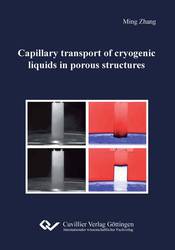| Areas | |
|---|---|
| Serie de libros (96) |
1378
|
| Nachhaltigkeit |
3
|
| Gesundheitswesen |
1
|
| Letra |
2364
|
| Ciencias Naturales |
5406
|
| Ciencias Ingeniería |
1793
|
| Ingeniería | 292 |
| Ingeniería mecánica y de proceso | 862 |
| Ingeniería eléctrica | 686 |
| Mineria y metalurgía | 30 |
| Arquitectura e ingeniería civil | 75 |
| General |
98
|
|
Leitlinien Unfallchirurgie
5. Auflage bestellen |
|
Erweiterte Suche
Capillary transport of cryogenic liquids in porous structures (Tienda española)
Ming Zhang (Autor)Previo
Lectura de prueba, PDF (210 KB)
Indice, PDF (49 KB)
In space, liquids behave differently than on earth due to lack of gravity. For gas-free propellant delivery a Propellant Management Device (PMD) or Liquid Acquisition Device (LAD) is often applied in space technology. Its proper functioning is ensured by employing porous structures due to the wicking effect (capillarity). A better understanding of wicking process with cryogenic liquids is essential for the design of future PMDs, which employ cryogenic propellants.
The first part of this work focuses on the mathematical modelling and experimental investigation of wicking processes with liquid nitrogen. The influence of liquid evaporation on wicking processes can be described by newly derived mathematical equations, which have a similar form to the Lucas-Washburn equation. The second part of this work deals with CFD simulations of wicking processes on both microscopic and macroscopic scales. Simulations on the microscopic scale aim to achieve structure parameters of the investigated porous media such as permeability, static pore radius and porosity. The surface geometries of the porous media are obtained through CAD program or computer tomography (CT). Simulations on the macroscopic scale treat porous structures as a macroscopic continuum, which is then described with previously obtained structure parameters.
| ISBN-13 (Impresion) | 9783954044436 |
| ISBN-13 (E-Book) | 9783736944435 |
| Formato | A5 |
| Idioma | Inglés |
| Numero de paginas | 234 |
| Laminacion de la cubierta | mate |
| Edicion | 1. Aufl. |
| Lugar de publicacion | Göttingen |
| Lugar de la disertacion | Bremen |
| Fecha de publicacion | 18.06.2013 |
| Clasificacion simple | Tesis doctoral |
| Area |
Ciencias Ingeniería
Ingeniería mecánica y de proceso |
| Palabras claves | capillary, wicking, cryogenic, porous, CFD, modeling, Darcy, Computer tomography, CT, permeability, evaporation, Technische Mechanik, Strömungsmechanik, Thermodynamik, Wärme-, Kälte- und Klimatechnik, Luft- und Raumfahrttechnik |








